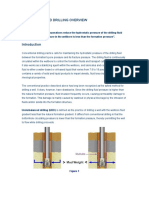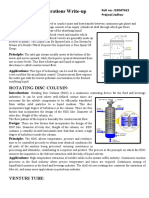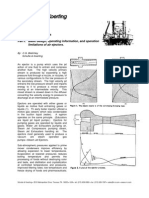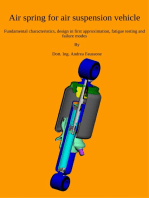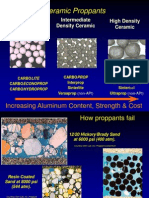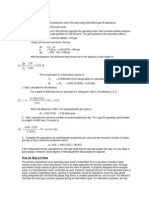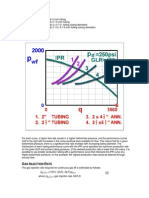Gas Lift Over
Gas Lift Over
Uploaded by
Mikhaelrams RamsCopyright:
Available Formats
Gas Lift Over
Gas Lift Over
Uploaded by
Mikhaelrams RamsCopyright
Available Formats
Share this document
Did you find this document useful?
Is this content inappropriate?
Copyright:
Available Formats
Gas Lift Over
Gas Lift Over
Uploaded by
Mikhaelrams RamsCopyright:
Available Formats
when compared to others.
Similarly, one artificial lift system will usually have at least one advantage over all others for a given set of operating conditions.
GAS LIFT SYSTEM OVERVIEW
Gas lift is a four-step process (Figure 1: Gas lift system):
Figure 1
1. 2. 3. 4.
Natural gas is compressed at the surface and routed to individual wells. This lift gas is injected downhole and into the produced fluid stream through one or more valves set at specified depths (most commonly, the gas is injected into the production tubing from the casing-tubing annulus). The lift gas and formation fluids are produced to the surface. The gas and liquids are separated; the gas is then treated and sent either to compression or to sales.
In most wells, gas is injected continuously into the produced fluid stream. This continuous gas lift process reduces the backpressure on the formation by reducing the densityand therefore the hydrostatic pressureof the produced fluid (Figure 2: Continuous gas lift).
Figure 2
Continuous gas lift is typically used in higher productivity wells to handle rates ranging from 100 up to 30,000 B/D. In wells with very high productivity indexes, even higher rates can be attained by injecting gas into the tubing and producing fluids through the casing-tubing annulus. Intermittent gas lift employs much of the same equipment as continuous lift, but its operating principle is completely different. Rather than lowering the density of the produced fluid so that it can produce in a continuous flow stream, intermittent lift works by physically displacing slugs of liquid to the surface (Figure 3: Intermittent gas lift):
Figure 3
When a certain volume of fluid accumulates in the wellbore, gas is injected into the tubing, where it lifts the column of fluid to the surface as a slug. As each liquid slug is produced, gas injection is interrupted to allow the fluid volume to build up again. Intermittent injection uses a timer or an adjustable choke located on the surface to control the gas injection. Cycling of gas injection is regulated to coincide with the accumulation of wellbore fluids.
Intermittent lift is generally used in wells with limited inflow potential (i.e., high productivity index with low average reservoir pressure or, alternatively, low productivity index with high reservoir pressure).
You might also like
- Oil and Gas Artificial Fluid Lifting TechniquesFrom EverandOil and Gas Artificial Fluid Lifting TechniquesRating: 5 out of 5 stars5/5 (1)
- QIT Flare Out RFI - 2020.12.23 Rev3Document4 pagesQIT Flare Out RFI - 2020.12.23 Rev3MelissaRamírezMoraNo ratings yet
- Estimate Draft Ver AC140 or AC100 ASTOM Corp.Document16 pagesEstimate Draft Ver AC140 or AC100 ASTOM Corp.iimcaemdwNo ratings yet
- Base Oil - Pertamina PDFDocument52 pagesBase Oil - Pertamina PDFspurwito46No ratings yet
- Liquid Liquid Extraction in A Packed BedDocument26 pagesLiquid Liquid Extraction in A Packed BedAr SaidNo ratings yet
- LC FiningDocument10 pagesLC FiningAnca DumitruNo ratings yet
- Gas LiftDocument66 pagesGas LiftWahyu NugrahaNo ratings yet
- Artificial Lift SystemsDocument5 pagesArtificial Lift Systemssudhir kumarNo ratings yet
- Artificial Lift PDFDocument44 pagesArtificial Lift PDFAshraf MansourNo ratings yet
- Artificial Lift MethodsDocument261 pagesArtificial Lift Methodskumar abhishek singhNo ratings yet
- Gas Lift SystemDocument12 pagesGas Lift SystemIrsalina NHNo ratings yet
- Gas Lift SystemDocument12 pagesGas Lift SystemCamilaNo ratings yet
- Gas Lift SystemDocument12 pagesGas Lift SystemMh GamesNo ratings yet
- Gas Lift System DesignDocument65 pagesGas Lift System Design'Aditz Nento S'No ratings yet
- Gas Lift SystemDocument12 pagesGas Lift SystemHuy QuangNo ratings yet
- Gas LiftDocument4 pagesGas LiftТатьяна НестеренкоNo ratings yet
- Gas LiftDocument2 pagesGas LiftArmando O GarciaNo ratings yet
- Gas Lift Methods Used For Crude Oil ExtractionDocument4 pagesGas Lift Methods Used For Crude Oil ExtractionsagarNo ratings yet
- Modeling and Control of Gas Lifted Oil WellsDocument13 pagesModeling and Control of Gas Lifted Oil WellsRoshan SharmaNo ratings yet
- Gas LiftDocument11 pagesGas Liftمحمد ناظمNo ratings yet
- Gas LiftDocument17 pagesGas LiftSaurabhNo ratings yet
- Plunger Enhanced Chamber Lift (Pecl) : TechnicalpaperDocument5 pagesPlunger Enhanced Chamber Lift (Pecl) : TechnicalpaperSergio PännäinNo ratings yet
- Well PerformanceDocument13 pagesWell Performanceعمر الفاروق صانع حضارةNo ratings yet
- Gas Lift OperDocument3 pagesGas Lift OperMikhaelrams RamsNo ratings yet
- Gas Lift2022 PDFDocument196 pagesGas Lift2022 PDFkasemelk1990No ratings yet
- Introduction To Plunger LiftDocument6 pagesIntroduction To Plunger LiftMiguel Urzagaste CruzNo ratings yet
- Continuous Gas LiftDocument2 pagesContinuous Gas Liftjohn philip villanuevaNo ratings yet
- Artificial Lift: by Sekar Learning Advisor - ProcessDocument35 pagesArtificial Lift: by Sekar Learning Advisor - ProcessYsaías Samanez VeraNo ratings yet
- Artificial LiftDocument35 pagesArtificial LiftVladan Prigara100% (1)
- Blann 1984Document8 pagesBlann 1984AanNo ratings yet
- Gas-Lift Operation & OptimizationDocument18 pagesGas-Lift Operation & Optimizationnawars100% (1)
- Gas AbsorptionDocument8 pagesGas Absorptionfarah hannahNo ratings yet
- Nodal Analysis IPIMSDocument80 pagesNodal Analysis IPIMShaiderNo ratings yet
- L6-TGN-101 (Rev 1) Artificial Lift PumpsDocument22 pagesL6-TGN-101 (Rev 1) Artificial Lift PumpsTomasPavlovicNo ratings yet
- Unesco - Eolss Sample Chapters: Artificial LiftDocument0 pagesUnesco - Eolss Sample Chapters: Artificial LiftSameh ZaguiaNo ratings yet
- Completion 8Document57 pagesCompletion 8Arvin AbbaspourNo ratings yet
- Compressor Horsepower: Gas Distribution and ControlDocument3 pagesCompressor Horsepower: Gas Distribution and ControlRahmat AbdullahNo ratings yet
- UCHDRIVE - Well Engineering and ConstructionDocument254 pagesUCHDRIVE - Well Engineering and ConstructionEmmanuel NNo ratings yet
- Design of Intermittent Gas Lift InstallationsDocument8 pagesDesign of Intermittent Gas Lift InstallationsDeny Fatryanto EkoNo ratings yet
- Spe 133268 MS PDFDocument18 pagesSpe 133268 MS PDFPhuc TruongNo ratings yet
- SJV Selection Ejectors PDFDocument9 pagesSJV Selection Ejectors PDFShiva Balan100% (1)
- Selection of Air Ejectors: Part I. Basic Design, Operating Information, and Operation Limitations of Air EjectorsDocument9 pagesSelection of Air Ejectors: Part I. Basic Design, Operating Information, and Operation Limitations of Air Ejectorsmyungkwan haNo ratings yet
- Air Ejector Selection PDFDocument9 pagesAir Ejector Selection PDFmyungkwan haNo ratings yet
- 2.2.1. Pengertian Gas Lift (GL)Document10 pages2.2.1. Pengertian Gas Lift (GL)HENRY ARDIANNo ratings yet
- Conventional Plunger Lift DesignDocument9 pagesConventional Plunger Lift DesignXuesong WuNo ratings yet
- Lea 1Document7 pagesLea 1vika1301No ratings yet
- Gas Lift Well OperationDocument2 pagesGas Lift Well OperationDeny Fatryanto EkoNo ratings yet
- Chapter 02Document58 pagesChapter 02MJ LagradaNo ratings yet
- Drive MechanismsDocument5 pagesDrive MechanismsVGNo ratings yet
- Makalah Akhir Pressure MaintenanceDocument13 pagesMakalah Akhir Pressure MaintenanceBarbara_LFC100% (1)
- Volumetric Methods and Stripping Operations: Muscat, Oman Training CenterDocument38 pagesVolumetric Methods and Stripping Operations: Muscat, Oman Training CenterAnwar Ul HaqNo ratings yet
- 3.2. Process Selection - Slides - 1Document51 pages3.2. Process Selection - Slides - 1Tran Van LinhNo ratings yet
- Artificial Lift (Part 2)Document49 pagesArtificial Lift (Part 2)chegg accountNo ratings yet
- Artificial Lift (Part 2) PDFDocument50 pagesArtificial Lift (Part 2) PDFShadishwaren ParameswaranNo ratings yet
- 589 PDFDocument10 pages589 PDFRezaNo ratings yet
- SPE 112108 Modeling and Simulation of Instabilities in Gas-Lifted Oil WellsDocument11 pagesSPE 112108 Modeling and Simulation of Instabilities in Gas-Lifted Oil Wellsmohamed fathyNo ratings yet
- Gas Well Deliquification 2010Document13 pagesGas Well Deliquification 2010Onlyonly MacNo ratings yet
- J18IMT622 - Mto Write UpDocument5 pagesJ18IMT622 - Mto Write UpPrajwal Dhananjay JadhavNo ratings yet
- ARTICLE Artificial LiftDocument8 pagesARTICLE Artificial LiftRyan Taw PoetraNo ratings yet
- SJV Selection EjectorsDocument9 pagesSJV Selection Ejectorskumarvns111No ratings yet
- AL2 Gas LiftDocument101 pagesAL2 Gas Liftبشير أحمد بشير لشهبNo ratings yet
- Installing Plunger Lift Systems in Gas Wells: Lessons LearnedDocument14 pagesInstalling Plunger Lift Systems in Gas Wells: Lessons Learnedgonza9No ratings yet
- Pneumatic and Hydrautic Conveying of Both Fly Ash and Bottom AshFrom EverandPneumatic and Hydrautic Conveying of Both Fly Ash and Bottom AshNo ratings yet
- Resin Coated SandDocument1 pageResin Coated SandMikhaelrams RamsNo ratings yet
- Water FracDocument1 pageWater FracMikhaelrams RamsNo ratings yet
- Ceramic ProppantsDocument2 pagesCeramic ProppantsMikhaelrams RamsNo ratings yet
- What If The Fracs Are NOT Longitudinal?Document1 pageWhat If The Fracs Are NOT Longitudinal?Mikhaelrams RamsNo ratings yet
- Gas Lift ValvDocument2 pagesGas Lift ValvMikhaelrams Rams0% (1)
- Mohr Circle ADocument3 pagesMohr Circle AMikhaelrams RamsNo ratings yet
- Proppand ConductivityDocument1 pageProppand ConductivityMikhaelrams RamsNo ratings yet
- Gas Lift Valve DomoDocument2 pagesGas Lift Valve DomoMikhaelrams RamsNo ratings yet
- Gas Lift StarDocument4 pagesGas Lift StarMikhaelrams RamsNo ratings yet
- Gas Lift Valve InjDocument3 pagesGas Lift Valve InjMikhaelrams RamsNo ratings yet
- Gas Lift ValvesDocument7 pagesGas Lift ValvesMikhaelrams RamsNo ratings yet
- Gas Lift ChamberDocument3 pagesGas Lift ChamberMikhaelrams Rams100% (1)
- Gas Lift DownDocument6 pagesGas Lift DownMikhaelrams RamsNo ratings yet
- Gas Lift ValvesDocument7 pagesGas Lift ValvesMikhaelrams RamsNo ratings yet
- Gas Lift OperDocument3 pagesGas Lift OperMikhaelrams RamsNo ratings yet
- German Language Guide: University of OxfordDocument59 pagesGerman Language Guide: University of OxfordMikhaelrams RamsNo ratings yet
- Course Outline - 30 Weeks Language: Russian Level: 1 Course BookDocument2 pagesCourse Outline - 30 Weeks Language: Russian Level: 1 Course BookMikhaelrams RamsNo ratings yet
- LL French VA5Document2 pagesLL French VA5Mikhaelrams RamsNo ratings yet
- Corrosion of Pipelines Used For CO2 Transport in CCS, Int J of Greehouse Gas Control, 2011Document8 pagesCorrosion of Pipelines Used For CO2 Transport in CCS, Int J of Greehouse Gas Control, 2011John BoranNo ratings yet
- The Effect of Substrate Concentration On The Rate of Reaction of Enzyme ActivityDocument6 pagesThe Effect of Substrate Concentration On The Rate of Reaction of Enzyme ActivityMaan PatelNo ratings yet
- Isomerization UnitDocument2 pagesIsomerization UnitNavin Ramjattan100% (1)
- Natural Gas SafetyDocument24 pagesNatural Gas SafetyrowdierNo ratings yet
- Amna-1Document25 pagesAmna-1Amna liaquatNo ratings yet
- Unit 6 - Chemical Reactions - Complete NotesDocument57 pagesUnit 6 - Chemical Reactions - Complete Notesapi-508178584No ratings yet
- Process Gas Compressors: Comprehensive Api 618 Compressor PortfolioDocument20 pagesProcess Gas Compressors: Comprehensive Api 618 Compressor PortfolioaliakbarNo ratings yet
- Skema Utilitas TerbaruDocument1 pageSkema Utilitas TerbaruAnas SubkhanNo ratings yet
- 3 - Calculations - Lecture 3Document42 pages3 - Calculations - Lecture 3Ayush ModiNo ratings yet
- Water System PQDocument46 pagesWater System PQasit_mNo ratings yet
- Cdi 6 Fire Protection and Arson InvestigationDocument117 pagesCdi 6 Fire Protection and Arson InvestigationTodd Ramiscal100% (1)
- Design & Development of 5 KW Downdraft Biomass GasifierDocument7 pagesDesign & Development of 5 KW Downdraft Biomass GasifierAksaralangit BudiyartoNo ratings yet
- Distillation Tower DesignDocument65 pagesDistillation Tower DesignAntonio SilvaNo ratings yet
- Presentation On Effluent Treatment PlantDocument17 pagesPresentation On Effluent Treatment Plantshah younisNo ratings yet
- Methyl Isocyanate (MIC) Rundown & Storage System: The Bhopal Gas Tragedy Technical Series Part 1 of 4Document3 pagesMethyl Isocyanate (MIC) Rundown & Storage System: The Bhopal Gas Tragedy Technical Series Part 1 of 4Jesse Haney IIINo ratings yet
- Oxidation and Reduction ReactionsDocument24 pagesOxidation and Reduction ReactionsHafiz HamidiNo ratings yet
- Fluidised Catalytic Cracker Hydrotreater RevampDocument8 pagesFluidised Catalytic Cracker Hydrotreater RevampyeeprietoNo ratings yet
- P&IDDocument19 pagesP&IDJonathan OngNo ratings yet
- Red Tek 12A: Questions & AnswersDocument2 pagesRed Tek 12A: Questions & Answersgef100% (1)
- Hazardous Area Equipment MarkingDocument1 pageHazardous Area Equipment MarkingAgus RianNo ratings yet
- Rates of Reaction: by Syed Arham AhsanDocument12 pagesRates of Reaction: by Syed Arham AhsanAryan HossainNo ratings yet
- Oil and GasDocument10 pagesOil and GassrajeceNo ratings yet
- Fuel Oil WikipediaDocument7 pagesFuel Oil WikipediacantgetausernameNo ratings yet
- 1 API RP 54 Occupational Safety and Health For Oil and Gas FOURTHDocument62 pages1 API RP 54 Occupational Safety and Health For Oil and Gas FOURTHMahmoud AbdelDayemNo ratings yet
- Fine Tuning Hydrocarbon ProcessingDocument7 pagesFine Tuning Hydrocarbon ProcessingVAIBHAV FACHARANo ratings yet























































